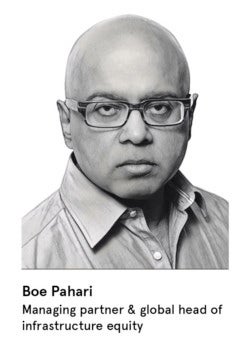 Smart investors have long recognised the infrastructure sector’s relative stability and reliable growth potential, and therefore its quality as an asset class. Yet the infrastructure environment has changed radically in recent decades and this presents challenges the industry must respond to.
Smart investors have long recognised the infrastructure sector’s relative stability and reliable growth potential, and therefore its quality as an asset class. Yet the infrastructure environment has changed radically in recent decades and this presents challenges the industry must respond to.
“Infrastructure is a much more complex place to invest than it was 20 years ago,” explains Boe Pahari, managing partner and global head of infrastructure at AMP Capital, an investment firm with tens of billions of dollars placed in the industry.
“Every asset class goes through a process of maturation and that’s certainly happened in infrastructure investing. As you acquire new assets and generate returns for investors through active management, the assets are derisked and over time move from privatisation to direct investors,” he says.
“The cycle is repeated as the asset class continues to evolve with new categories of risk. This means you need the right sector expertise to respond to the changing pace of infrastructure as it continues to represent essential assets and services in contemporary urban living.”
There are four distinct causes of continued disruption in the infrastructure space – globalisation, urbanisation, digitisation and demographics.
Globalisation has meant a huge surge in the use of air travel, particularly in emerging markets, as well as strong demand for the creation of regional airport hubs, which in many cases are now also created as large-scale retail and commercial real estate destinations. Train services have also seen increased demand, bolstered by environmental awareness.
Meanwhile, urbanisation has resulted in significant shifts in demand for industrial-scale energy storage and localised power generation. In essence, with cities seeing their number of inhabitants swell year on year, energy demands are increasing and supplies need to be managed in the most economically and environmentally viable ways.
At the same time, the trend towards digitisation is strong, and demand is relentless for services based on fibre-optic and wireless connectivity. “Across the world, bandwidth has increased forty five times in the last ten years. The impact has been enormous on infrastructure, in terms of telecoms towers and mobile technology,” Mr Pahari says.
Meanwhile, global demographic changes are extensive, including quickly ageing populations in many countries. “By 2035, around 20 per cent of the population of the world will be 65 or older,” Mr Pahari explains. “That represents a significant burden of responsibility for the public sector to look after the more senior sections of its populations.”
It is also important to remember that with governments across the globe burdened with high levels of debt, fewer infrastructure projects are being publicly funded. Private capital is stepping in.
All these changes mean a significant new world for investors. Asset allocation is shifting increasingly towards platforms and away from more traditional core infrastructure. Taking the emergence of Uber as an example of a broader trend, Mr Pahari says that for infrastructure investors, the value is moving away from physical assets, such as taxi businesses, towards the digital platforms that underpin popular services. “Being part of the platform is the way we need to go forward,” he says.
Understanding such driving forces is critical for investors as they look to minimise risks and identify value, investing in both listed equity and private debt. In no small part, the challenge is to assess the fast-changing dynamics of infrastructure markets accurately to seize the opportunities, predict where they are going and invest with eyes open to the future.
AMP Capital’s “truly global” presence, with offices in Sydney, Delhi, Dubai, London, New York and Los Angeles, gives it a strong basis for getting as close as possible to a comprehensive appreciation of all the pertinent trends, Mr Pahari says.
But having a global network of offices is not enough for any investment manager. “The next thing you have to do is go out there, experience the changes yourself and spend time talking to people, trying to understand where the world is headed,” he notes. For investment management firms of the scale of AMP Capital, it is essential to be deeply entrenched in the infrastructure sector and offer real expertise to secure consistently correct decisions.
“The group of people we have working on our assets, from origination to management to board members to governance, is highly extensive, it’s comprehensive and their ideas are very carefully thought through,” says Mr Pahari. “Investors rely on this, so we pay close attention to building and retaining our expert skills base.”
By doing so, the company can aim to bring “genuine sector expertise into sharp focus in all these different locations and environments”, he says. Underlying all that, though, Mr Pahari insists: “You need to value your own people and listen to them very carefully. They’re out there in the markets listening and coming back to you with myriad ideas about opportunities and potential threats.”
AMP Capital is extensively invested in the major areas of disruption, from its presence in local airports, such as Newcastle and Leeds Bradford, to local power, wireless connectivity, and the provision of care for elderly people.
But even an operation with the scale and local presence of AMP Capital cannot sit back and expect routinely to predict the future. “Being ready for what lies ahead, against a backdrop of profound and constant change, is a challenge we always need to rise to,” says Mr Pahari. “The only response is to be fully embedded in the infrastructure industry, to see the changes coming, and to have the skills to respond and invest well.”
To find out how to invest successfully in the new infrastructure and be ahead of disruptive trends please visit ampcapital.com

